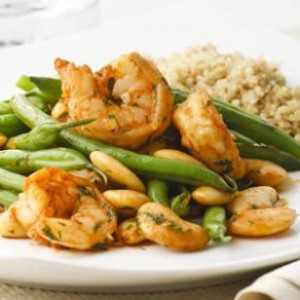Fill Up On Fiber
Dietary fiber does more than just prevent constipation. It can be beneficial in helping to maintaining a healthy weight, help reduce the risk of developing hypertension, certain gastrointestinal diseases, certain cancers, heart disease and diabetes. But where does fiber come from and what are the best sources? Fiber comes from whole grains, vegetables, fruits, legumes and nuts. Fiber is not digested by the body. There are two classes of fiber: soluble (dissolvable in water) and insoluble (does not dissolve in water). Soluble fiber dissolves to form a gel in the stomach. It binds to fatty acids which helps to lower total and LDL (bad ) cholesterol. It also delays stomach emptying so that sugars are absorbed at a slower rate. This in turn helps to regulate blood sugar for people who have diabetes and pre-diabetes. Good sources of soluble fiber include:
- Oats
- Beans
- Apples
- Citrus fruits
- Barley
- Flaxseeds
- Nuts
- Psyllium
Insoluble fiber binds with water as it passes through the digestive track, aiding to prevent constipation, hemorrhoids and diverticulosis. It also helps to give a feeling of fullness, which can aid in weight loss. Good sources of insoluble fiber include:
- Wheat bran
- Whole grains
- Seeds
- Nuts
- Cruciferous vegetables (ie:cauliflower and broccoli)
- Dark green leafy vegetables
- Potatoes
It is always best to get your fiber through a healthy, nutritious diet when possible rather than through supplements. How much fiber do you need? Men need 38 grams/day, Women need 25 grams/day when 50 years or younger. If 51 and older: Men, 30 grams/day, Women, 21 grams/day. Remember, as you increase your fiber, you will need to increase your water consumption. Increasing your fiber too quickly can lead to gas and bloating, so go slow!
Some ways to add fiber in your everyday diet:
- Start your day with a healthy breakfast. Look for a cereal with 5 grams of fiber or 1 cup of oatmeal and some blueberries
- Have an apple with some nut butter or raw veggies and hummus as a snack
- Have a meatless Monday and incorporate whole grains and legumes
- Don’t drink fruit juices-eat your fruit
Paprika Shrimp & Green Bean Saute
From EatingWell: January/February 2009
Makes: 6 servings
Active Time: 30 minutes
Total Time: 30 minutes
NUTRITION PROFILE
INGREDIENTS
- 4 cups green beans, trimmed (about 12 ounces)
- 3 tablespoons extra-virgin olive oil
- 1/4 cup minced garlic
- 2 teaspoons paprika
- 1 pound raw shrimp, (21-25 per pound; see Note), peeled and deveined
- 2 16-ounce cans large butter beans, or cannellini beans, rinsed
- 1/4 cup sherry vinegar, or red-wine vinegar
- 1/2 teaspoon salt
- 1/2 cup chopped fresh parsley, divided
- Freshly ground pepper, to taste
PREPARATION
- Bring 1 inch of water to a boil in a large saucepan. Put green beans in a steamer basket, place in the pan, cover and steam until tender-crisp, 4 to 6 minutes.
- Meanwhile, heat oil in a large skillet over medium-high heat. Add garlic and paprika and cook, stirring constantly, until just fragrant but not browned, about 20 seconds. Add shrimp and cook until pink and opaque, about 2 minutes per side. Stir in beans, vinegar and salt; cook, stirring occasionally, until heated through, about 2 minutes. Stir in 1/4 cup parsley.
- Divide the green beans among 6 plates. Top with the shrimp mixture. Sprinkle with pepper and the remaining 1/4 cup parsley.
TIPS & NOTES
- Note: Shrimp is usually sold by the number needed to make one pound. For example, “21-25 count” means there will be 21 to 25 shrimp in a pound. Size names, such as “large” or “extra large,” are not standardized. In recipes calling for a specific count, order by the count (or number) per pound to be sure you’re getting the size you want.
- To peel shrimp, grasp the legs and hold onto the tail while you twist off the shell. Save the shells to make a tasty stock: Simmer, in enough water to cover, for 10 minutes, then strain. The “vein” running along a shrimp’s back (technically the dorsal surface, opposite the legs) under a thin layer of flesh is really its digestive tract.
- To devein shrimp, use a paring knife to make a slit along the length of the shrimp. Under running water, remove the tract with the knife tip.
NUTRITION
Per serving: 245 calories; 8 g fat ( 1 g sat , 6 g mono ); 115 mg cholesterol; 26 g carbohydrates; 0 g added sugars; 23 g protein; 8 g fiber; 596 mg sodium; 855 mg potassium.
Nutrition Bonus: Selenium (43% daily value), Fiber (33% dv), Vitamin C (30% dv), Iron (25% dv), Potassium (24% dv), Vitamin A (20% dv).
Carbohydrate Servings: 2




